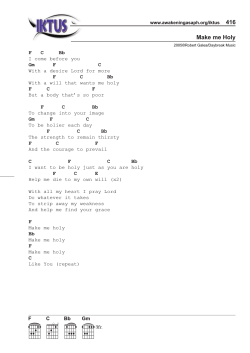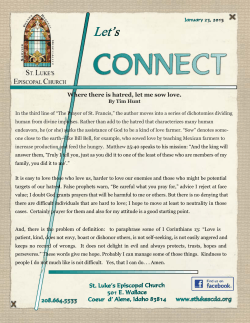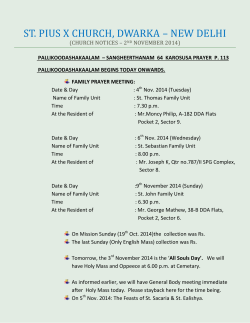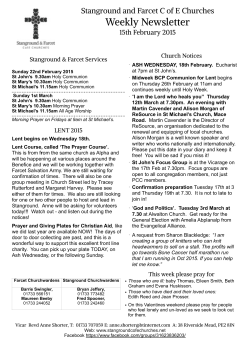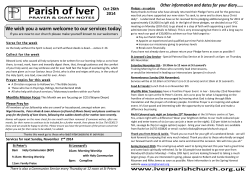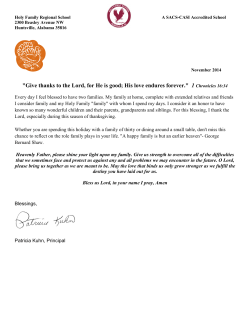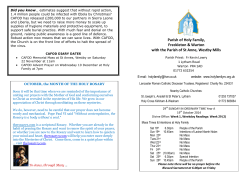
Stephanian - st. stephens indian orthodox church,kuwait
Prayer Meeting Schedule for March.-2015 Schedule of Worship : Venue - ACE’s Hall , Near Subway Rest., Abbasiya Every Friday Holy Qurbana - 6 : 30 am - 9 am. (Morning Service) Every Saturday Holy Qurbana - 6:30 pm to 8:30 pm (Evening Service) Holy Qurbana on 2nd Saturday (14-03-15) 7:00 am to 9:00 am (NECK South Tent) Vol. 2, Issue :3 Parish Bulletin March 2015 Stephanian St. Stephens Indian Orthodox Congregation Kuwait Irine Elsa George Jerom V Jiji For private circulation only H E A R T F U L W I S H E S Free Transportation Facility : To & fro free transporation facility is available to all who attend the Holy Qurbana of SSIOC at ACE Hall, Abbasiya. Contact : Mr. Abraham P.K. - 60473158 Mr. Cherian V.T. (Farwaniya) : 99285095, Mr. V.T. Mathew (Salmiya) : 90949681 Parish Trustee : Mr. Laji Joseph : 99916457, Parish Secretary : Mr. Shaju John : 66776676 Emil Mathew Birthday & Wedding Anniversary : The Vicar & parishoners extend blissful happy B’day & Wedding Anniversary wishes to all whose same marks on the month of March. (Special prayer is offered in Holy Qurbana for them.) Sebin Thomas Sunday School Talent Scan will be on 20th March, Friday 10: 30am to 3:30 pm at St. John’s Marthoma Hall, Abbasiya. 06-03 20-03 27-03 Feast of Annunciation to St Mary (Vachanippu Perunnal) : The Holy Qurbana will be celebrated on 24-03-15 at Ace’s Hall Abbasiya, Time : 6:00 pm. 06-03 13-03 20-03 27-03 Midlent : The Holy Qurbana and the special service of Midlent will be celebrated on 10-03-15 at Ace’s Hall Abbasiya (Near Subway Rest.) Time : 6:00 pm Ajin Abraham Biju Please bring your Hasha Azhcha Namskara Kramam, Holy Bible and Suvishesha Geethangal on Good Friday Service. Evening Prayer & Holy Confession : Sunday to Wednesday 6:30 pm Venue : Ace’s Hall Abbasiya (Near Subway Rest.) 06-03 13-03 20-03 27-03 6:00 pm Evening Prayer, Midnight Prayer, Easter Service & Holy Qurbana 06-03 13-03 20-03 27-03 Palm Sunday Service (28.03.15) - Indian Com. School, Khaitan 6:00 pm Evening Prayer, Hosana Service & Holy Qurbana Maundy Thursday Service (01.04.15)-Indian Com. School, Khaitan 6:30 pm Evening Prayer & Holy Qurbana Good Friday Service (03.04.15) - Indian Com. School, Khaitan 7:30 am - 3:30 pm Prayers of hours, Proc. of the Cross Devotional Address, Adoration of the Cross 6:30 pm - Evening Prayer & Meditation at Parsonage Gospel Saturday Service (04.04.15) - Indian Com. School, Khaitan 7:30 am Morning Prayer & Holy Qurbana Easter Service (04.04.15) - Indian Com. School, Khaitan St. Gregorios Prayer (Abbasiya) Secretary : Mr. Binu Varghese - 66764194 / 65837243 (Time -pm) Flr. 04 Flat 20 99675163 Time Out Restaurant Building Mrs. Suja Reji 5:00 Behind Telecommunication 01 07 24338029 Mr. Binny Mathew 5:00 Opp. Unique store No. 3 Gf 02 50104545 Mr. Minu Varghese 5:00 St. Basil Prayer (Abbasiya) Secretary : Mr. Alex P. George - 97435242 Mr. Biju Joy 5:00 Tall Building, near to Jas Cargo, 64 66456865 06 19 24311372 5:00 05 Mr. John Varghese Opposite to Euro Asia Travels 14 65004988 5:00 GF Mr. Scaria Thomas Jenny's Beauty Parlour Building 5:00 25 99182907 06 Mr. Ajoy Jacob George Opposite to Al Razi Pharmacy St. Dionysius Prayer (Abbasiya) Secretary : Mr. Thomas Varghese - 99274419 06 99274419 5:30 Ryan Thomas Scaria Near Apsara Bazar 01 Mr. Thomas Varughese Abel Abraham Anil Near Blazer Tailors 06 Mr. Stephen K Thomas 18 66284410 5:30 Near Eden Stores 04 90949681 Mr. Mathew V.T 11 5:30 Opposite Best Bakery 08 Mr. Jiji Alex 5:30 38 66408576 St. George Prayer (Abbasiya) Secretary : Mr. Geevarghese Cherian - 66045301 5:30 09 66045301 Corner 2nd Bldg, Near Hada Centre 03 Mr. Geevarghese 34 96629861 Spicy Restaurant Bldg. 05 Mr. Shibu Abraham 5:30 97824160 Golden Supermarket Bldg. 07 Mr. Biju George 5:30 Gulf Dream Supermarket Bldg. 05 20 99640342 Mr. Libu K Varghese 5:30 St. Mary’s Prayer (Riggai) Secretary : Mr. Babukutty K. Mathew - 50322192 Devon Babu Benson Michelle Mariam Pharmacy 1 Bldg, Near Reggai Garden Signal Mr. Elson Thomas 04 16 99254828 7:30 Bldg. #105, (Al Bahar Bldg.) Old Riggae Mr. Lovin Thomas 01 03 50923239 7:30 St. Thomas Prayer (Farwaniya & Khaitan) Secretary : Mr. Cherian V.T - 99285095 Near Carmel School, Khaitan 06 66 99916457 7:00 Mr. Laji Joseph St. John’s Prayer (Hawally, Salmiya & Abuhalifa) Secretary : Mr. Shibu Abraham - 51077900 Block1, Street12, Near Appolo Hospital, Salmiya 01 99694284 GF 6:30 Mr. Shiju Yohannan By the grace of God, the Holy Passion Week of this year will be celebrated as per the schedule given below. All are cordially invited to attend with prayers in the entire services & get blessings in abundance. 06-03 20-03 (Lam. 1: 12) 14-03 20-03 HOLY WEEK SERVICES 2015 Is it nothing to you, all you who pass by? Vicar : Fr.Saju Philip, Mob. - 60696128 / 24347327 AN INTRODUCTION TO THE HOLY BIBLE (... Cont) The Canon of the Bible We have seen that the texts in the Bible have been composed a different places and in different ages. The way they have been collected and compiled deserves special study. This leads us to the subject: The Canon of the Bible. The Old Testament Canon The Greek word canon means a measuring rod or carpenter’s rule. Canonic texts mean texts which are approved or the basic texts. The Old Testament canon defines the authoritative texts in the Old Testament. But there was no such official declaration or authoritative text in the Jewish Church till 1st century A.D. It cannot be definitely said when each text in the Old Testament came to be approved as the basic. All that can be said is that they came to be approved in course of time; but we cannot connect it to a particular person or generation. It can be undoubtedly said that of all the O.T. texts it was the Tora, the texts of law that first became known and approved. Its contents remained as in the oral tradition for many centuries. The fathers taught the children; thus it was handed down from generation to generation. The advice and counsels which thus remained widely known were later collected in the form of books. It is said that the scroll of a book thus written was seen in the temple during the period of (BC 639-608) of Kind Josiah. Josiah’s reforms were on the basis of this book. It is to be supposed that the Tora or the texts of law and the history books were collected and published during the period of the exodus. We see that Ezra read out and taught the people the books of Tora (Nehemiah 8:1,5,8). After the Tora the books of prophecy may have been approved by the Jewish Church. The Jews included Samuel and King among the books of prophecy. By the end of 3rd century B.C. all the books of prophecy were approved by the Jewish Church. In the third section of the Old Testament Kethubim, the holy writings, Ezra Nehemia, Psalms and the compositions of Solomon were included. It must be sumrised that these books ere approved by the Jewish Church by the end of B.C. IInd century. During the time of the persecution by Antiochus Ephiphanos many Jewish works were destroyed. It is recorded that the rest were collected and preserved by Judas Maccabius. 39 Books in three sections were approved in Palestine. But it cannot be said that there was any official decision concerning this. Alexandria was a strong centre where the Jews lived scattered. Therein 3rd century B.C. the Greek translation of the Old Testament text was done. This is known as the Septuagint. (LXX) This bible has contents much more elaborate than the known and approved in Palestine. That is to say more texts were included. Had a canon been decided before that, nobody would have included more books. The original of the texts included was Greek. The books of Maccabias, Ben Sirah, etc. are found only in the Septuagint. It was the Septuagint Bible that the Christian Church used from the beginning. Jamnia Council When the Christian Church made a strong move forward, there were many attempts of resistance against it form the Jewish community. They tried to prove that Christians were aliens and enemies to their community. Sometime towards A.D. 90 the Jewish Rabbis met in a conference Jamnia near Joppa. They took several decisions against the Christian Church. In order to establish that the Old Testament used by the Christians were not their Bible, they decided that only 39 books that were current in Palestine were in their Bible. They rejected the remaining books holding up some criteria. So the Jews made and declared a canon for the Old Testament only at the end of the first century A.D. and that too was just to face the challenge of the Christian Church. Till Reformation it was the Septuagint with its 46 books that was in current use. But the Reformation leaders accepted the Palestinian canon with its 39 books. The unaccepted books came to be called Deutero Canonical books. Cont... THE STUDY OF SACRAMENTS - HOLY BAPTISM (... Cont) Anointing the Forehead As per the service order of St. Severius, the first part of the baptismal service ends with the recitation of the creed. In the second part, the baptized’s forehead is smeared with olive oil in the form of across. The meaning of this is mentioned in the prayer recited before anointing. “O Lord, You sent Your Holy Spirit and created this Your servant from nothingness and brought him/her into existence. He /she has been made worthy of Holy Baptism through Your love of mankind. Establish him/her on the foundation of the holy apostles, and plant him / her as a true sapling in Your Holy Church. Send Your Holy Spirit upon him/her so that s/he may be worthy of the sacramental anointing. Fill him / her with Your divine gifts. Make Your light shine in the heart of this Your worshiper, so that s/he may be free from the slavery of sin.” Further, the forehead is anointed. During anointing, the priest prays: “….. is sealed with the oil of gladness, that s/he may be worthy of adoption as son by being born again.” There is a wrong notion among many that the consecration of the Holy Myron (moroon) is to exorcise evil powers. In the ancient church, the practice of exorcism is fulfilled by the oil of the exorcism. But in Orthodox tradition, this oil is not referred to with this name. We call it the oil of gladness (Ps 45:7). Moses Bar-Kepha comments on this anointing in the following words: “The reason mentioned below are the causes of anointing the baptized with oil. Firstly, the candidate has to wage on the battle against Satan. To defeat the opponent the combatant smears his body with oil. Similarly this oil makes the baptized victorious against the satanic forces”. The anointing with the olive oil also serves the purpose of grafting the wild olive believer with the true olive that is Christ. This view is supported by Bar Kepha. By rejecting Satan and by accepting Christ, Satan looks for an opportunity to defeat man, to save the candidate from the onslaught of Satan; the sign of the cross is made on the candidate’s forehead. This opinion is voiced by St. John Chrysostom. Because of the sign of the cross on the forehead, Satan fears to even look at the faithful. Under the dazzling influence of the sign of the Cross the eyes of Satan gets dazzled. The Arabian metropolitan bishop Geevarghese says that in Egypt, the Israelites were saved from the angel of death through the sign on their doorpost. Similarly the anointing sing on the forehead forces Satan to leave the believer unharmed. This view is held by George, the Bishop of Arabia. Blessing Water a. Warm and cold water After anointing of the forehead, the water is blessed. Of all the rites related to the blessing of the water, the first event is the mixing of hot and cold water when water is mixed the following prayer is recited: “Through the supplication of our feebleness, O Lord, we pray that this water may be mixed with the power and operation of Your Holy Spirit, so that this may be a spiritual womb and a crucible which brings forth incorruptibility. May this water be to Your servant, who is being baptized, the garment of incorruptibility and deliverance from the bonds of sins. For You are the giver of all goods gifts, and to You we offer glory, and to Your Only – Begotten Son and to Your Holy Spirit now and forever and ever.” In the interpretations on baptism, no description can be seen on this event. The above-mentioned prayer states the power and indwelling of the Holy Spirit mixed (in the water) thereby leading to “spiritual womb and indestructible casting furnace”. According to Syrian tradition, the baptismal font is also addressed as “womb” and “furnace”. It’s called a furnace due to the presence of the Holy Spirit that signifies fire. According to St. Ephrem, the presence of the Holy Spirit or fire is evident in baptism. For the remission of sin, the fire that resembles the Holy Spirit is mixed in the water. In the same way, the Holy Spirit is merged in the bread used in the Holy Qurbana. The Eastern Syrian poet, Narsai states that the baptismal font is transformed into a furnace. Similar to a furnace the priest transforms bodies into new forms. The mortal remains are destroyed in the fire. The heat of the spirit eradicates the rust of the body and the mind. Cont...
© Copyright 2025
